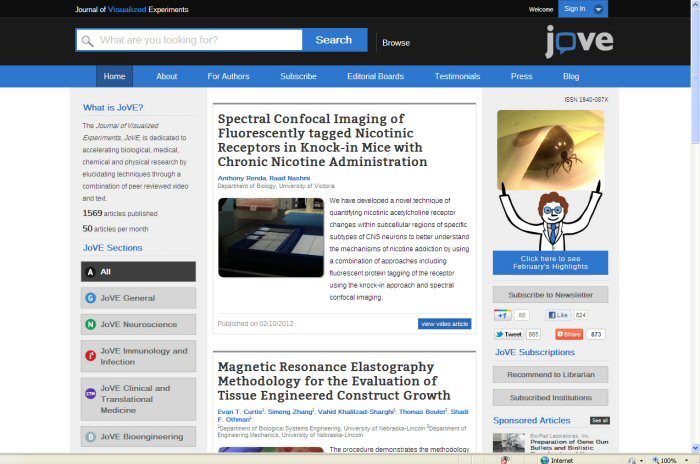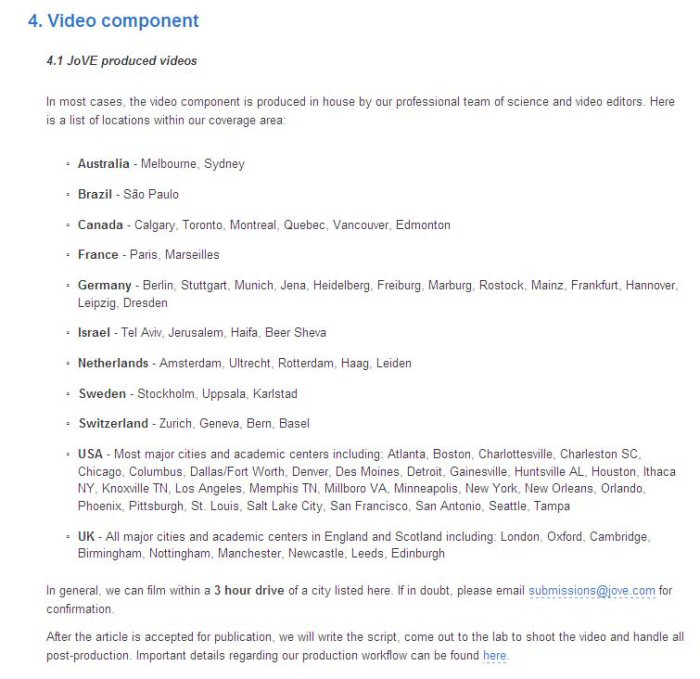| URLs in this document have been updated. Links enclosed in {curly brackets} have been changed. If a replacement link was located, the new URL was added and the link is active; if a new site could not be identified, the broken link was removed. |
Electronic Resources Reviews and Reports
JoVE: Not Just a Publisher, a Film Producer
Beth McGowan
Health/Human Sciences Librarian
bmcgowan@niu.edu
Meredith Ayers
Science Librarian
mayers@niu.edu
University Libraries
Northern Illinois University
DeKalb, Illinois
Established roughly five years ago, The Journal of Visualized Experiments (JoVE) is the brain child of Brian Pritsker who, when doing his PhD research, found himself obliged to travel to England to learn experimentation methods. He decided that a cheaper and more time-effective method to learn experimental methodology would be to watch a video of methods while learning of an experiment's results. And while the sense that there ought to exist an alternative to travelling thousands of miles to witness experimental techniques may not have been that unusual, the innovative JoVE or the Journal of Visualized Experiments is.

To Pritsker's credit, he has assembled an impressive board of editors with an international reach for the video journal. The board of editors includes faculty from major universities across North America and Europe including Harvard, Cornell, Princeton, the National Institutes of Health, the University of Zurich, University of Wuerzburg and Institut Pasteur & Paris Descartes University. The journal covers many areas of what they designate the life sciences, each area understood as distinct from the others including the following categories: General; Neuroscience; Immunology and Infection; Clinical and Translational Medicine; Bioengineering and Basic Protocols. Generally this very broad range of possible areas would be unworkable. But as the principle goal of the journal is to make visible and thus reproducible experimental methods, and, it seems to actually provide research results, the breadth of the subject may not be as unwieldy as it originally seems. The breadth, however, does suggest an ambition to become a major interdisciplinary resource, and more of a database than a traditional "journal".
In addition to the broadness of scope, other processes set JoVE apart from traditional journals, specifically its editorial process. In many ways the editorial process mirrors processes of other journals: authors submit articles, these articles are reviewed by an on staff editorial board then referred to peer reviewers for decisions; revisions may or may not be requested for final submission to the journal. But these "articles" do not report research results, but instead, the experimental method (Thompson 2011).
The editorial process is both abbreviated and enlarged in this journal. For example, the page informs potential authors that copyediting for the written form of the article is optional. This is an unusual state of affairs for any publisher since editing and copy editing are generally some of their basic services. But as this journal is not merely involved in editing but simultaneously involved in creating video to complement print materials, the articles must therefore be "translated" into video by the journal staff. How this is done is not precisely clear from their web site. They inform us that:
The first step is for the video editor to review the step-by-step protocol for clarity in order to enable them to translate it into a script. The script will contain:
- The text of the introductory and conclusion segments, which are spoken by the senior and demonstrating authors.
- A shot-by-shot description of the protocol section of the video.
- The text of the voice-over that will accompany each shot (JoVE, JoVE Produced Articles 2011).
What is not clear is who is doing this writing. One assumes they are the editors listed as making up part of "The Team" on the journal's home page and not the professional videographers available in so many areas of the globe. The translation of an article into "script" is then forwarded to the authors to read and correct. The major authors become the faces in the films made. The authors of these scripts, their professionalism and scientific acumen, will need to be of the highest quality if the journal is truly to become noteworthy and valuable, yet they remain unidentified on the web site (JoVE, The team 2011).
Beyond this criticism, the JoVE provides professional videographers in the US, UK, Europe, Australia, South America, and the Middle East. This is an impressive international reach for a relatively new and innovative sort of journal. However it must be noted and is not surprising that scientists in less fortunate regions of the world are at a distinct disadvantage. Africa is not at all covered and Brazil is the only country in Latin America where videographers are available (see Figure 2). The journal does not, however, require that videos be produced by the journal's own team. Authors may submit their own videos, already produced, if they have the means and the willingness to do so.

JoVE is so new that it has very few "articles" in its database -- 1,569 articles as of February 10, 2012. (The number is updated daily on the web site.) And while the journal adds about 50 articles a month -- a legitimate, even robust, number -- its entire collection is as yet rather paltry. Originally conceived as open access, the journal found it could not survive this way and began charging for subscriptions. The journal continues to allow partial access to all videos (Zhang 2011). Only subscribing institutions may view the films in their entirety. Even subscribers do not have access to all films in all subject categories, but only the videos in the categories they subscribe to. JoVE offers a sliding scale to different types of institutions: $2,400 per year for a university with PhD programs; $1,600 for a masters-level institution; and $1,000 for colleges (Zhang 2011). This rather steep price and the limited range of materials could be a deal breaker, especially considering that a user may want either a very specific experimental method or a broad base of methodologies and with only 1,569 articles in all, one is not likely to get the coverage wanted. Furthermore, librarian users have reported that the sales staff is not fully trained and that turnover among their number is high (Thompson 2011).
In spite of the subscription costs, the JoVE requires that authors provide a substantial contribution to offset the costs of publication. An author may choose to subsidize full open access by contributing $4,200 or may contribute $2,400 for standard access. Both of these sums assume that JoVE is responsible for the writing and filming of the video describing the article. Authors who prefer to create their own material for standard access contribute $850, while open access still costs $2,650 (JoVE, Publishing basics, 2011).
The most valuable element of the journal's video presentation of articles is the video exposition of experimental methodologies. In the case of scientific research, the picture truly is worth 1,000 words. Or perhaps the cost of a subscription.
References
JoVE. 2012. JoVE Produced Articles. [Internet]. [Accessed February 10, 2012]. Available from {http://www.jove.com/page.php?name=joveproduced}.
________. 2011. Publishing Basics. [Internet]. [Accessed December 7, 2011]. Available from. {https://www.jove.com/author}
________. 2011. The Team. [Internet]. [Accessed December 7, 2011]. Available from {http://www.jove.com/about/team}
Thompson, Larry. 2011. JoVE Feedback. Message to eldnet-1 electronic mailing list. 15 December 2011. E-mail.15 December 2011. {https://mailman1.u.washington.edu/mailman/private/eldnet-l/}
Zhang, Y. 2011. Review of Journal of Visualized Experiments (JoVE). The Charleston Advisor July 2010:31-34.
| Previous | Contents | Next |
